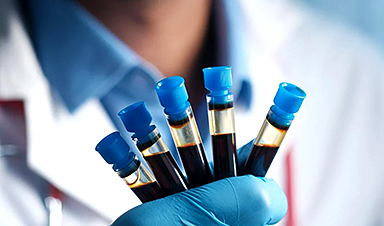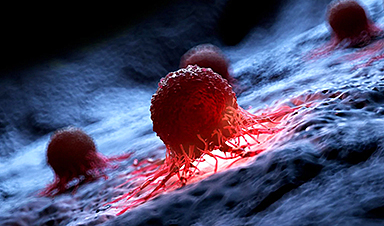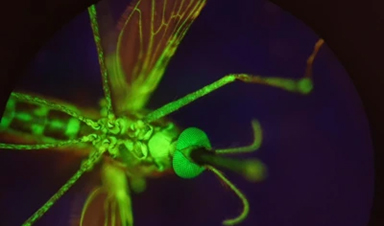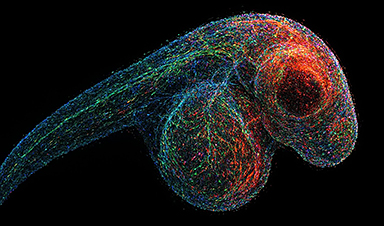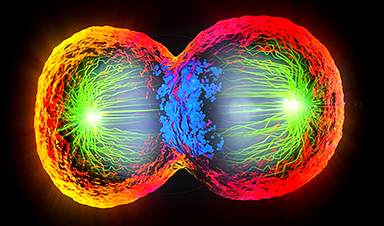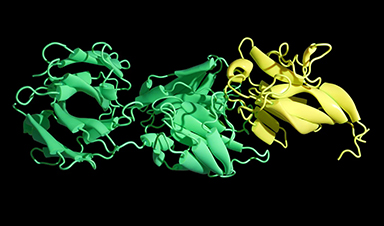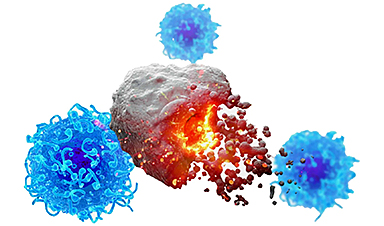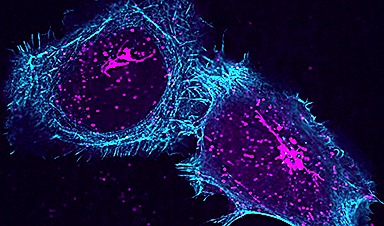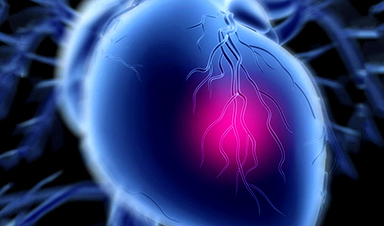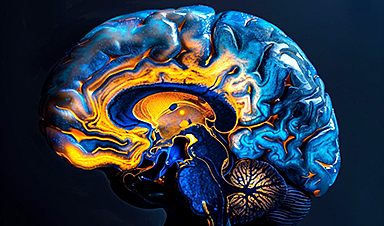New insights could advance microfluidics and drug delivery systems.
- New study finds obstacles can trap rolling microparticles in fluid
- Through simulations and experiments, physicists attribute the trapping effect to stagnant pockets of fluid, created by hydrodynamics
- Random motions of the molecules within the fluid then ‘kick’ the microroller into a stagnant pocket, effectively trapping it
- Size of the obstacle also controls how easy it is to trap a microroller and how long it remains trapped
When physicists steered a tiny microparticle toward a cylindrical obstacle, they expected one of two outcomes to occur. The particle would either collide into the obstacle or sail around it. The particle, however, did neither.
The researcher team — led by Northwestern University and École Polytechnique in France — was surprised and puzzled to watch the particle curve around the obstacle and then stick to its backside. The obstacle, it seemed, had the particle effectively trapped.
After a series of simulations and experiments, the researchers unraveled the physics at play behind this strange phenomenon. Three factors caused the unexpected trapping behavior: electrostatics, hydrodynamics, and erratic random movement of the surrounding molecules. The size of the obstacle also determined how long the particle remained trapped before escaping.
The study will be published on March 8 in the journal Science Advances.
“I didn’t expect to see trapping in this system at all,” said Northwestern’s Michelle Driscoll, who co-led the study. “But trapping adds a lot of utility to the system because now we have a way to gather up particles. Tasks like trapping, mixing and sorting are very difficult to do at such small scales. You can’t just scale down standard processes for mixing and sorting because a different kind of physics kicks in at this size limit. So, it’s important to have different ways to manipulate particles.”
Driscoll is an assistant professor of physics at Northwestern’s Weinberg College of Arts and Sciences. She co-led the study with Blaise Delmotte, a researcher at École Polytechnique.
Similar in size to bacteria, microrollers are synthetic, microscopic particles with the ability to move in a fluid environment. Driscoll and her team are particularly interested in microrollers for their ability to move freely — and quickly — in different directions and their potential to carry and deliver cargo in complex, confined environments, including within the human body.
The microrollers in Driscoll’s lab are plastic with an iron oxide core, which gives them a weak magnetic field. By putting the microrollers in a sealed microchamber (100 millimeters by 2 millimeters by 0.1 millimeters in size), researchers can control the direction they move by manipulating a rotating magnetic field around the sample. To change the way the microrollers move, researchers simply reprogram the motion of the magnetic field to pull the microrollers in different directions.
But microfluidic devices and the human body are, of course, much more complex landscapes compared to a featureless sample chamber. So, Driscoll and her collaborators added obstacles to the system to see how microrollers could navigate the environment.
“For true-to-life applications, you aren’t just going to have this system with particles sitting in an open space,” Driscoll said. “It’s going to be a complex landscape. You might have to move the particles through winding channels. So, we wanted to first explore the simplest version of the problem: One microroller and one obstacle.”
In both computer simulations and the experimental environment, Driscoll and her team added cylindrical obstacles to the sample chamber. Sometimes the microroller sailed around the obstacle without issue, but other times it would swing around the obstacle and then get trapped behind it.
“We watched the particle stop moving past the obstacle and kind of get stuck,” Driscoll said. “We saw the same behavior in the simulations and in the experiments.”
By changing the parameters within the simulations and analyzing the data, Driscoll and her team found the hydrodynamics of the fluid inside the sample chamber created stagnant areas. In other words, the spinning microroller caused the fluid to flow in the chamber. But the flows also created pockets — including one directly behind the obstacle — where the fluid remained still and unflowing. When the particle entered the stagnant area, it stopped moving and became stuck.
But to reach the stagnant area, the particle had to perform a baffling U-turn. After moving past the obstacle, the microroller curved around it, becoming stuck to its backside. Driscoll found that random motions (called Brownian motion) of the molecules within the fluid “kicked” the microroller into the stagnant area.
“Tiny materials are subject to Brownian fluctuations,” Driscoll explained. “The fluid is not actually a continuum but is composed of individual, little molecules. Those molecules are constantly ramming into the particle at random orientations. If the particle is small enough, these collisions can move it. That’s why if you look at tiny particles under a microscope, they look like they are juggling around a little bit.”
Driscoll’s team also found that the size of the obstacle controls how long the particle will remain trapped before escaping. For example, it’s easier for Brownian fluctuations to kick the particle into the trapping region when the obstacle is smaller. By changing the obstacle size, researchers can increase the trapping time by orders of magnitude.
“Usually, Brownian fluctuations are destructive to experiments because they are a source of noise,” Driscoll said. “Here, we can leverage Brownian motion to do something useful. We can enable this hydrodynamic trapping effect.”
News
New Blood Test Detects Alzheimer’s and Tracks Its Progression With 92% Accuracy
The new test could help identify which patients are most likely to benefit from new Alzheimer’s drugs. A newly developed blood test for Alzheimer’s disease not only helps confirm the presence of the condition but also [...]
The CDC buried a measles forecast that stressed the need for vaccinations
This story was originally published on ProPublica, a nonprofit newsroom that investigates abuses of power. Sign up to receive our biggest stories as soon as they’re published. ProPublica — Leaders at the Centers for Disease Control and Prevention [...]
Light-Driven Plasmonic Microrobots for Nanoparticle Manipulation
A recent study published in Nature Communications presents a new microrobotic platform designed to improve the precision and versatility of nanoparticle manipulation using light. Led by Jin Qin and colleagues, the research addresses limitations in traditional [...]
Cancer’s “Master Switch” Blocked for Good in Landmark Study
Researchers discovered peptides that permanently block a key cancer protein once thought untreatable, using a new screening method to test their effectiveness inside cells. For the first time, scientists have identified promising drug candidates [...]
AI self-cloning claims: A new frontier or a looming threat?
Chinese scientists claim that some AI models can replicate themselves and protect against shutdown. Has artificial intelligence crossed the so-called red line? Chinese researchers have published two reports on arXiv claiming that some artificial [...]
New Drug Turns Human Blood Into Mosquito-Killing Weapon
Nitisinone, a drug for rare diseases, kills mosquitoes when present in human blood and may become a new tool to fight malaria, offering longer-lasting, environmentally safer effects than ivermectin. Controlling mosquito populations is a [...]
DNA Microscopy Creates 3D Maps of Life From the Inside Out
What if you could take a picture of every gene inside a living organism—not with light, but with DNA itself? Scientists at the University of Chicago have pioneered a revolutionary imaging technique called volumetric DNA microscopy. It builds [...]
Scientists Just Captured the Stunning Process That Shapes Chromosomes
Scientists at EMBL have captured how human chromosomes fold into their signature rod shape during cell division, using a groundbreaking method called LoopTrace. By observing overlapping DNA loops forming in high resolution, they revealed that large [...]
Bird Flu Virus Is Mutating Fast – Scientists Say Our Vaccines May Not Be Enough
H5N1 influenza is evolving rapidly, weakening the effectiveness of existing antibodies and increasing its potential threat to humans. Scientists at UNC Charlotte and MIT used high-performance computational modeling to analyze thousands of viral protein-antibody interactions, revealing [...]
Revolutionary Cancer Vaccine Targets All Solid Tumors
The method triggers immune responses that inhibit melanoma, triple-negative breast cancer, lung carcinoma, and ovarian cancer. Cancer treatment vaccines have been in development since 2010, when the first was approved for prostate cancer, followed [...]
Scientists Uncover Hidden Protein Driving Autoimmune Attacks
Scientists have uncovered a critical piece of the puzzle in autoimmune diseases: a protein that helps release immune response molecules. By studying an ultra-rare condition, researchers identified ArfGAP2 as a key player in immune [...]
Mediterranean neutrino observatory sets new limits on quantum gravity
Quantum gravity is the missing link between general relativity and quantum mechanics, the yet-to-be-discovered key to a unified theory capable of explaining both the infinitely large and the infinitely small. The solution to this [...]
Challenging Previous Beliefs: Japanese Scientists Discover Hidden Protector of Heart
A Japanese research team found that the oxidized form of glutathione (GSSG) may protect heart tissue by modifying a key protein, potentially offering a novel therapeutic approach for ischemic heart failure. A new study [...]
Millions May Have Long COVID – So Why Can’t They Get Diagnosed?
Millions of people in England may be living with Long Covid without even realizing it. A large-scale analysis found that nearly 10% suspect they might have the condition but remain uncertain, often due to [...]
Researchers Reveal What Happens to Your Brain When You Don’t Get Enough Sleep
What if poor sleep was doing more than just making you tired? Researchers have discovered that disrupted sleep in older adults interferes with the brain’s ability to clean out waste, leading to memory problems [...]
How to prevent chronic inflammation from zombie-like cells that accumulate with age
In humans and other multicellular organisms, cells multiply. This defining feature allows embryos to grow into adulthood, and enables the healing of the many bumps, bruises and scrapes along the way. Certain factors can [...]

